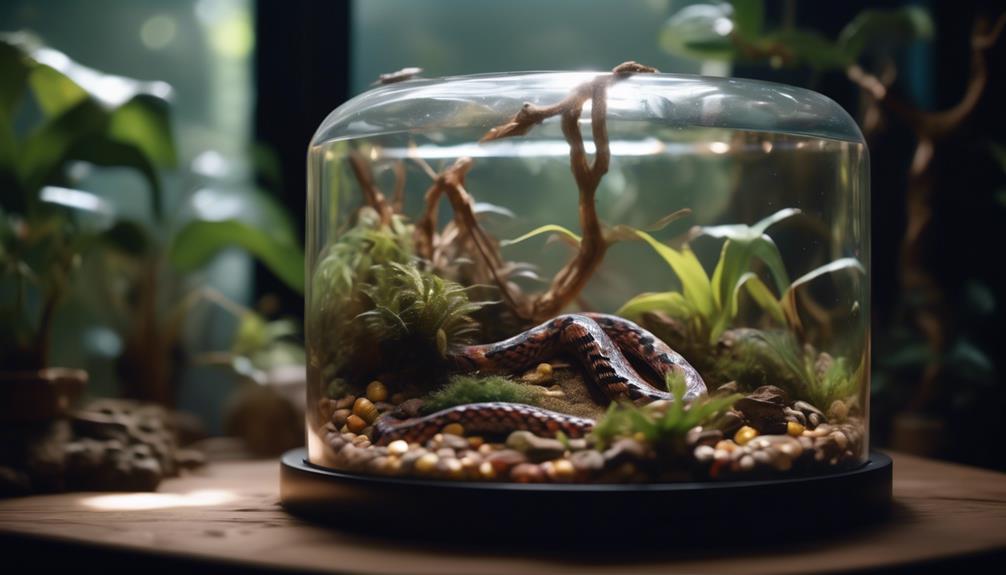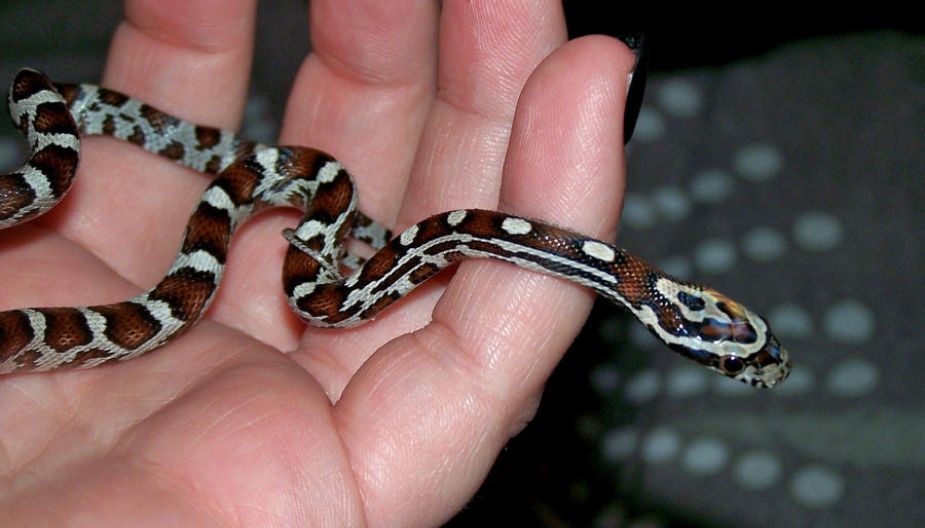Imagine building a safe and cozy home for your new corn snake, like creating the perfect nest for a delicate bird to thrive. It's a process that requires attention to detail and a bit of patience, but the end result is truly rewarding.
As you embark on this journey of crafting an ideal habitat for your corn snake, you'll find that every step holds its own significance in ensuring the comfort and well-being of your new scaled friend. With the right guidance, you can successfully create a sanctuary that not only meets your snake's needs but also becomes a captivating centerpiece in your living space.
Selecting the Right Enclosure Size
When choosing the right enclosure size for your corn snake, consider the snake's current size and its potential for growth to ensure adequate space for movement and comfort. The enclosure dimensions should be at least 75% of the snake's total body length.
For a young corn snake, a 20-gallon long tank (30x12x12 inches) would suffice, but as the snake grows, a 40-gallon breeder tank (36x18x16 inches) or larger might be necessary.
Ventilation requirements are crucial for maintaining a healthy environment within the enclosure. Adequate ventilation helps to prevent the buildup of excess humidity and allows for the circulation of fresh air.
It's recommended to have ventilation holes on both the sides and the top of the enclosure to facilitate proper airflow. The size and number of ventilation holes should be carefully calculated to strike a balance between air circulation and maintaining the necessary humidity levels.
Additionally, ensure that the enclosure has a secure lid to prevent any potential escape and to maintain a consistent temperature and humidity level within the enclosure.
Choosing Substrate and Décor
Select a suitable substrate for your corn snake enclosure based on its natural habitat and your preferences for maintenance and aesthetics. Corn snakes benefit from substrates that mimic their natural environment, such as aspen shavings, cypress mulch, or paper-based bedding. These options provide good moisture retention and allow for burrowing, which is a natural behavior for corn snakes. Alternatively, reptile carpet or tile can be used for easier maintenance and cleanliness, although they may not offer the same enrichment opportunities as loose substrates.
When it comes to decor choices, providing enrichment is essential for a corn snake's well-being. Branches and climbing structures offer mental and physical stimulation, mimicking their natural behavior of climbing in the wild. Additionally, hiding spots such as caves or half-logs are crucial for reducing stress and providing security. When selecting decor, prioritize items that are easy to clean and sanitize to maintain a hygienic environment for your snake.
Ensuring a balance between enrichment and cleanliness is key when choosing substrate and decor for your corn snake enclosure. By considering your snake's natural habitat and your maintenance preferences, you can create a stimulating and hygienic environment for your snake to thrive.
Setting Up Heating and Lighting
To ensure the optimal well-being of your corn snake, it's essential to carefully set up the heating and lighting within its enclosure, replicating its natural habitat as closely as possible. The heating source should be placed at one end of the enclosure to create a thermal gradient, allowing your snake to move between warmer and cooler areas as needed. Use a thermostat to regulate the temperature and ensure it stays within the recommended range of 75-85°F (24-29°C) on the cooler end and 85-90°F (29-32°C) on the warmer end.
Additionally, a lighting schedule mimicking natural day-night cycles is important for your snake's circadian rhythm. While corn snakes don't require UVB lighting, providing a 12-hour light-dark cycle can help regulate their activity and aid in their overall well-being.
Remember to monitor the temperature regularly and adjust the heating source as needed, especially during seasonal changes. By carefully managing the heating and lighting in your corn snake's enclosure, you can create a comfortable and stimulating environment that promotes their health and natural behaviors.
Maintaining Proper Humidity Levels
Maintaining proper humidity levels in your corn snake enclosure is essential for supporting their respiratory health and overall well-being. Corn snakes require a humidity level of 40-60% in their enclosure to thrive. Here are some tips to help you maintain the ideal humidity levels for your corn snake:
- Use a quality hygrometer to monitor humidity levels accurately.
- Provide a large water bowl for your snake to soak in, which helps to increase humidity.
- Use a substrate that retains moisture well, such as cypress mulch or sphagnum moss.
- Incorporate live plants into the enclosure, as they can help naturally regulate humidity levels.
- Consider ventilation solutions such as adjustable vents or fans to help control humidity levels more effectively.
Feeding and Handling Tips
Ensuring the well-being of your corn snake also involves understanding the best feeding and handling practices to maintain their overall health and vitality, especially after establishing the ideal humidity levels in their enclosure.
When it comes to feeding, corn snakes thrive on a diet of appropriately sized rodents, such as mice or rats. A general rule of thumb for feeding adult corn snakes is every 7-10 days, while younger snakes may require more frequent feeding, typically every 5-7 days. It's crucial to monitor your snake's body condition and adjust the feeding schedule as needed to prevent underfeeding or overfeeding.
When handling your corn snake, it's important to do so with care and gentleness. Always support the snake's body and allow it to move at its own pace. Handling should be limited to 10-15 minutes at a time, a few times a week, to minimize stress on the snake. Avoid handling your snake for a few days after it has eaten to prevent regurgitation.
Regular, gentle handling can help your snake become more accustomed to interaction and reduce stress, contributing to its overall well-being.
Conclusion
Now that you have completed the setup of your corn snake enclosure, it's time to sit back and watch your new pet thrive in its new environment.
Remember to monitor temperature and humidity levels regularly, and provide a variety of hiding spots and climbing opportunities for your snake.
With proper care and attention, your corn snake will be a happy and healthy addition to your home for years to come.
Happy herping!


